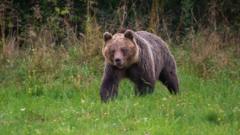The Slovak government has formally approved a directive to cull around 350 brown bears, which constitutes nearly 27% of the estimated 1,300 bears inhabiting the country. This decision came in the wake of a tragic incident in which a man was fatally mauled by a bear while walking in a forest near Detva.
**Slovakia Announces Controversial Culling of 350 Bears Following Fatal Attack**

**Slovakia Announces Controversial Culling of 350 Bears Following Fatal Attack**
In response to increasing encounters with aggressive bears, Slovakia has extended measures to allow the culling of a significant portion of its brown bear population. This controversial decision follows a recent fatal bear attack, igniting debates on wildlife management and conservation.
Prime Minister Robert Fico’s administration indicated that the growing number of bear attacks presents a serious risk to public safety. "We can't live in a country where people are afraid to go into the woods," Fico emphasized during a press briefing. The new state of emergency provisions now apply to 55 of Slovakia's 79 districts, reflecting the widespread nature of the intended culling initiative.
Conservation advocates have strongly condemned the government's approach, arguing that it contravenes environmental protections and could be illegal under international law. Michal Wiezek, an ecologist and opposition member, labeled the plan as “absurd,” criticizing the government for failing to address the root causes of human-bear conflicts. He urged the European Commission to take action.
The fatality marks a disturbing trend in bear-related incidents within Slovakia, which have notably increased in recent years. Additional high-profile cases include the death of a Belarusian woman pursued by a bear earlier this year, and numerous sightings of bears venturing into urban areas, raising alarm amongst local populations.
Environmental officials note that the bear population has remained stable, countering claims of an overpopulation issue. Environment Minister Tomas Taraba suggested that a sustainable target population for bears would be around 800. Nonetheless, the ongoing debate over the culling strategy highlights the complexities of managing wildlife in regions where human expansion and natural habitats collide.
As the government prepares to implement these culling measures, the tension between public safety and wildlife preservation continues to dominate discussions in Slovakia.
Conservation advocates have strongly condemned the government's approach, arguing that it contravenes environmental protections and could be illegal under international law. Michal Wiezek, an ecologist and opposition member, labeled the plan as “absurd,” criticizing the government for failing to address the root causes of human-bear conflicts. He urged the European Commission to take action.
The fatality marks a disturbing trend in bear-related incidents within Slovakia, which have notably increased in recent years. Additional high-profile cases include the death of a Belarusian woman pursued by a bear earlier this year, and numerous sightings of bears venturing into urban areas, raising alarm amongst local populations.
Environmental officials note that the bear population has remained stable, countering claims of an overpopulation issue. Environment Minister Tomas Taraba suggested that a sustainable target population for bears would be around 800. Nonetheless, the ongoing debate over the culling strategy highlights the complexities of managing wildlife in regions where human expansion and natural habitats collide.
As the government prepares to implement these culling measures, the tension between public safety and wildlife preservation continues to dominate discussions in Slovakia.






















